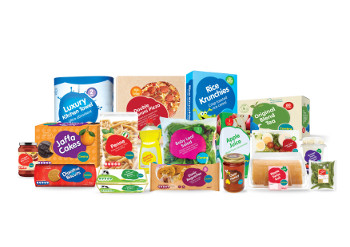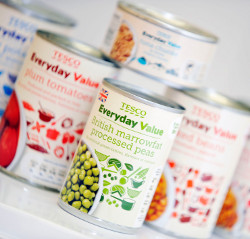Lookalike branding

A recent survey found that a fifth of consumers had mistakenly picked up an own-brand product believing it to be the branded version. Established brands are facing stiff competition from discount retailers who are challenging consumers' brand loyalty. Fiona Donnellan reports.
14 May 2013

In the fight for consumer loyalty, shelf appearance is essential in grabbing the attention of shoppers. No longer the poor relation, own-label foods are the rising stars of supermarket shopping. There has been an increasing amount of products hitting the shelves that look suspiciously like the established brand, albeit with a lower price tag. A recent Which? survey found that ‘copycat’ brands are rife within the grocery sector and some consumers are confusing them with the branded version. Discount retailers are taking advantage of consumers’ desire to get the same products for less by launching their own range of premium products at lower prices.
Copycat packaging
The confusion displayed by shoppers has some merit. The Which? survey found 150 own-brand products that looked almost identical to the branded version. Typically, these lookalike products were in categories where there are well-established and distinctive brands, such as crisps, biscuits, butter and toiletries. A Which? spokesperson said: "Own-brand products can provide good value and several have topped our tests to become best buys. But shops should make sure that people are under no illusions about what they are buying and not leave so many consumers feeling that they have been misled." Consumers who pick up own-brand products by mistake are often left feeling misled and angry. Clear labeling of the product as own-brand is evident in the majority of stores but there are some exceptions. Aldi and Lidl both seem to fly close to the wind on this issue.
Lidl is currently running an advertising campaign entitled ‘Brand Challenge’ in which it claims its brands are more popular than the established rivals. According to promotional material from the German discounter, the challenge was "conducted on a small selection of our brands by research experts Coyne who carried out testing throughout Ireland and Northern Ireland on both everyday and luxury items. The survey was undertaken from a demographic of up to 300 people per products using a representative sample of grocery shoppers who regularly consume the relevant product categories." Lidl claims that its products are over 50% cheaper than the rival branded products. The discount store declined to comment to ShelfLife at the time of going to print.

Own-brand range without a name
Aldi is also standing up to the established brands in the grocery market. Its marketing campaign compares well known brands with its own-brand products making a point to highlight the difference in price while maintaining taste and quality. In a statement to ShelfLife, Aldi said it "offers its customers a range of high quality, exclusive own brand groceries and household products at the best price possible."
However, despite the Which? survey using several Aldi products as examples of ‘copycat’ branding, the discounter said its own-brand range has been created exclusively for the retailer. "All Aldi own-brand products are chosen to appeal to Irish consumers’ tastes. The packaging design and brand names on the products are exclusive to Aldi and are carefully researched and developed to fulfil customer’s expectations. Aldi stocks very few branded products ensuring there is no customer confusion with Aldi’s own-brand range."
According to the Which? survey, own-label products – which tend to be cheaper than brands – are becoming more enticing to consumers, and a similarity to a brand can be a reason to buy an own-label product – when surveyed on lookalike packaging, 18% of Which? members said they’ve deliberately bought an own-label product because it resembled a branded one. While the products are Aldi own-brand, they are produced by a number of different suppliers and are not grouped under an Aldi symbol. They are not highlighted as being Aldi’s own-brand range and some certainly seem to borrow elements of packaging and design from established products already on the market.
Brand confusion
Unilever is one of the country’s leading FMCG players, with a turnover of £2.5 billion. The company owns 40 brands, spanning 14 categories and has a household penetration of 98% in the UK. Unilever told ShelfLife that while it respects customers’ choice, ‘copycat’ branding can be misleading. "Unilever fully supports consumer choice and robust competition on price, quality and taste. We welcome the study by Which? – as a highly respected product-testing and consumer campaign charity – and its role in providing an independent perspective on this topic.
"However, Unilever believes it is in the interests of consumers, brand owners and retailers that competing products are clearly distinguishable from each other and that creating confusion for consumers in the marketplace should be actively avoided. The copying of shape, colour and format elements, as embodied in many of the examples highlighted in the study, is potentially confusing, not necessary and also does not represent fair competition."
Legal challenge
The fight for customers has brought some companies face to face across the courtroom. In December 2012, Tesco and Aldi settled their case out of court with Tesco agreeing to pay €150,000 to the discount retailer as part of a legal settlement. Aldi sued Tesco over inaccurate price comparisons. In a statement, Aldi said it "repeatedly brought the matter to the attention of Tesco" over the last number of years but was disappointed that no action was taken and that Tesco continued to use "inaccurate comparative advertising". One of the examples given by Aldi was a tin of spaghetti. On a shelf-edge label, Tesco compared its 410g value tin of spaghetti at 22c to an Aldi 410g tin of spaghetti priced at 46c, despite the fact that Aldi had another tinned spaghetti product in-store also priced at 22c.
In another example, Tesco compared its maple syrup priced at €2.55 with a more expensive Aldi maple syrup priced at eur*2.87, without making it clear that the Tesco product was only 40% made up of maple syrup, while Aldi’s was 100% maple syrup. Other examples included wine, cereals, meat, bread, wine, vodka and frozen foods.
As part of the settlement, Tesco undertook not to engage in misleading price comparisons, not to compare products which have different weights without stating the fact, not to compare products that are similar but have different ingredients, to display the country of origin of fresh food products when making price comparisons and display correctly alcohol products that have different alcohol volume, age, vintage, colour, country or quality.
Commenting on the case, Aldi Stores (Ireland) group buying director, Niall O’Connor said: "The effect of today’s undertakings is that consumers can expect and demand clear, transparent and accurate information on comparative advertising to enable them to make properly informed decisions about what they buy and who they buy from." Aldi donated the money received in the settlement to St Vincent de Paul.
Brand versus brand
It’s not just own-brands competing against established branded products. In 2011 bread producer McCambridge took rival bakery firm Brennans to court over its ‘copycat’ brown bread packaging. The company said it decided to take action after being contacted by a number of customers who mistakenly purchased Brennans Stoneground Wholewheat Loaf instead of the McCambridge version. McCambridge said that people were buying the rival product because of the confusingly similar packaging, which featured matching fonts and a green block of colour.
The High Court granted an injunction which would prevent Brennans from using the packaging in November 2011 but that decision was appealed. In August 2012, the Supreme Court upheld the injunction and Brennans was ordered to remove all of its brown bread products which feature the packaging by the following day.
Rising share of the market
Market research has shown consistent market growth for Aldi and Lidl in recent months. The latest supermarket share figures from Kantar Worldpanel in Ireland, for the 12 weeks ending 14 April, show the discounters continue to set the pace with Aldi and Lidl posting respective growth rates of 28.5% and 7.3% and gaining a record share of the market.
David Berry, commercial director at Kantar Worldpanel, said: "Aldi and Lidl hold a combined 13.1% record share of the grocery market. Both retailers have succeeded in recruiting more shoppers while also encouraging existing customers to spend more. The average spend by a discounter shopper has increased from €187 last year to €209 in the same 12 week period this year. The winning performance of the discounters has placed significant competitive pressure on the other retailers. SuperValu has posted the strongest response with an extra 80,000 shoppers driving growth of 1.3% and keeping it ahead of the market. Superquinn is another positive performer for the Musgrave Group, recording sales growth for the second successive month."
Meanwhile, growth for Dunnes Stores continues, albeit at a lower rate of 0.4% leading to a slight dip in market share to 22.5%. Tesco continues to perform behind the market with its share now standing at 27.7%. These figures show the success that discounters like Aldi and Lidl are having in gaining customers with the range of own-brand products available.
Change is in the air
Recent studies have also found that the average weekly shopping basket is getting smaller – some manufacturers have been shrinking the packet sizes of many top-selling groceries. From biscuits and crisps to rice and dishwasher tablets, manufacturers are making products smaller in what a consumer watchdog described as "price hikes by stealth". The Consumers’ Association of Ireland condemned the practice of product shrinkage. "It’s very unfair on consumers because it’s effectively price hikes by stealth," said its chief executive, Dermott Jewell. However several brands engaging in the practice, argued that faced with increasing costs, they were forced to introduce slightly smaller pack sizes, rather than increase prices. Put simply, they knew more expensive products would be a non-runner from the get-go with budget conscious shoppers. It’s easy to see why such logic could prevail among brand owners, especially considering the increasing pressure they’re facing from the burgeoning own-brand market.
Own-brand products are on the rise, not just in discounters like Aldi and Lidl, but in supermarket chains and convenience stores as well. Just last month Centra launched its Bright New range of over 900 products, representing a €8 million investment; the largest investment in its 34 year history. SuperValu, Spar and Mace, along with other symbol groups also have well established own-brand ranges which are proving popular with shoppers. With retailers working harder than ever to give their own-label lines the cachet of branded products, own-labels have become brand labels in their own right and in some categories have achieved brand leadership. The question remains: what are the longer-term impacts for established brands?



 Print
Print






Fans 0
Followers